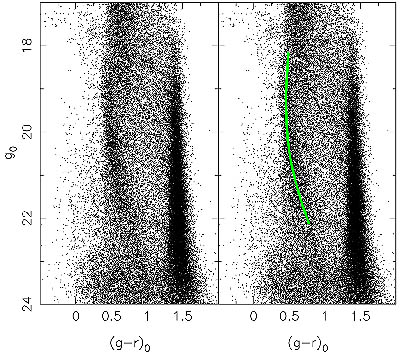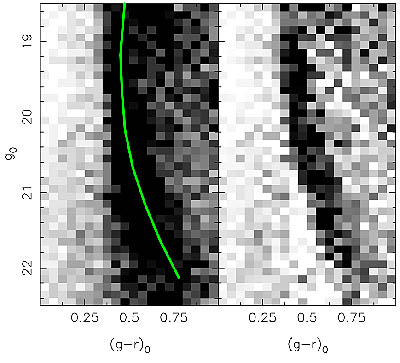ONE RING TO
ENCOMPASS THEM ALL
INT+WFC, WFS archive
A vast, but previously unknown structure was discovered
around our own Milky Way galaxy by an international team of astronomers.
Their observations suggest that there is a giant ring of several hundred
million stars surrounding the main disk of the Milky Way. Despite its
size, the ring has not been clearly seen before since the stars are spread
around the whole sky, and are far fewer in number than the tens of billions
of stars making up the rest of the Galaxy.
Although known to be warped, probably from encounters
with its orbiting satellite galaxies, the disk of the Milky Way was
otherwise thought to be a relatively simple structure. The disk is roughly
100,000 light years across, with the Sun embedded in it and offset some
30,000 light years from the centre. From this vantage point, the nearest
edge of the ring is about 30,000 light years away, in the direction of the
constellation Monoceros, opposite the centre of the Galaxy. This region
of sky is where traces of the ring were first discovered.
Further detailed surveys in the constellation Andromeda showed
that stars belonging to the ring are visible 100 degrees away from the
original discovery site and that these stars closely mimic the vertical
distribution of the Milky-Way's so-called thick disk. Additional survey
areas also serendipitously yielded evidence of the ring's presence, allowing
the astronomers to get the first hints of the immense size of the structure.
The data, taken with the Isaac Newton Telescope
Wide Field Camera, show a population narrowly aligned along the line
of sight, but with a galactocentric distance that changes from  15 to
15 to  20 kpc. Despite being narrowly concentrated along the line of sight,
the structure is fairly extended vertically out of the plane of the disc,
with a vertical scaleheight of 0.75 ± 0.04 kpc. The structure
is seen both below the Galactic plane and above it, covering a vertical
range of more than 50°. The fields at higher Galactic latitude than |b|
20 kpc. Despite being narrowly concentrated along the line of sight,
the structure is fairly extended vertically out of the plane of the disc,
with a vertical scaleheight of 0.75 ± 0.04 kpc. The structure
is seen both below the Galactic plane and above it, covering a vertical
range of more than 50°. The fields at higher Galactic latitude than |b| 30° did not show up a similar colour-magnitude diagram feature.It
seems roughly to encircle the disk, but is considerably thicker, probably
shaped like a giant doughnut. The structure appears to be confined
close to the Galactic plane. Assuming that the ring is smooth and axisymmetric,
the total stellar mass in the structure may amount to
30° did not show up a similar colour-magnitude diagram feature.It
seems roughly to encircle the disk, but is considerably thicker, probably
shaped like a giant doughnut. The structure appears to be confined
close to the Galactic plane. Assuming that the ring is smooth and axisymmetric,
the total stellar mass in the structure may amount to  2×108 M
2×108 M up to
up to  109 M
109 M .
.

|
This schematic figure illustrates
the geometry of the newly discovered ring, in relation to the spiral structure
of the Milky-Way. It has long been supposed that the disk of the Milky
Way galaxy slowly declines in brightness, vanishing into darkness at its
edge 50,000 light years from its centre. This startling new discovery shows
the outer regions of the disk are considerably more complicated than previously
thought, and sheds new light on the evolutionary history of our Galaxy.
[ JPEG | TIFF ]
|
Owing to our location within the disc of the Milky
Way, studies of the global structure of this Galactic component are hampered
by projection problems, crowding, dust, and the presence of intervening
populations (such as the bulge). Nowhere is this so problematic as in the
study of the very outer edge of the disc. The advent of the recent wide-area
infrared surveys (e.g. 2MASS and DENIS) have alleviated the extinction problem,
but the other problems remain, with the distance ambiguity being particularly
limiting. Even the future astrometric mission GAIA is unlikely to give
us a full picture of the Galactic disc, owing to telemetry limits in regions
of high stellar density.
The INT WFS devotes a large fraction of observing
time to deep and wide-field surveys. Many fields have now been observed
since 1998. In examining INT WFC survey fields, the discovery team of astronomers
has been able to detect the presence of this unexpected feature in several
distant fields. However, the resulting coverage at the present time is
patchy, with most time having been spent in large extragalactic surveys
towards the Galactic polar caps. In the following figure an example of
one of these fields is displayed, the Elais field N1, located at l=
85°, b=+44°, which shows the normal Galactic stellar
population sequences. The Galactic disc dwarfs contribute to the well-populated
red vertical structure at ( g - r )0 1.4, whereas the progressive main-sequence turn-offs of the thick
disc and halo give rise to the blue vertical structure at ( g
- r )0
1.4, whereas the progressive main-sequence turn-offs of the thick
disc and halo give rise to the blue vertical structure at ( g
- r )0 0.5. Eventually, at magnitudes fainter than g 0
0.5. Eventually, at magnitudes fainter than g 0 22, the halo sequence curves round to the red because of the rapidly
falling density at large Galactocentric distance. The right-hand panel
shows the same data as the left-hand panel, but with the ridge-line of the
structure of interest superposed.
22, the halo sequence curves round to the red because of the rapidly
falling density at large Galactocentric distance. The right-hand panel
shows the same data as the left-hand panel, but with the ridge-line of the
structure of interest superposed.

|
The colour-magnitude diagram of
the Elais field N1 (l= 85°, b=+44°), which it is used as a control
field. This comparison region shows the usual Galactic components.
[ GIF ]
|
Next figure displays the colour-magnitude diagram
of the INT WFC field WFS-0801 (located at l=180°, b=+30°);
a population that follows a track similar to a narrow main sequence is
seen in addition to the usual Galactic components. This sequence is shown
more clearly in the right-hand panel of the following figure, in which
the Elais-N1 field has been used as a background to subtract the normal
Galactic components.

|
The colour-magnitude diagram of
a field WFS-0801 at l=150°, b=+20°. An additional
colour-magnitude feature is present here over the expected disc, thick
disc and halo components, and is seen as a narrow colour-magnitude diagram
structure, similar to a main sequence with turn-off at ( g
- r )0 0.5, g 0
0.5, g 0 19.5 (in the Vega system). The right-hand panel shows this ridge-line
overlaid on the colour-magnitude diagram. The similarity in the turn-off
colour of this feature and that of the Galactic thick disc and halo shows
that its stellar population is of comparable age to those ancient Galactic
components. [ GIF ]
19.5 (in the Vega system). The right-hand panel shows this ridge-line
overlaid on the colour-magnitude diagram. The similarity in the turn-off
colour of this feature and that of the Galactic thick disc and halo shows
that its stellar population is of comparable age to those ancient Galactic
components. [ GIF ]
|

|
The left-hand panel shows the Hess
diagram of the INT WFS-0801 field and the right-hand panel displays
the result of subtracting the Elais-N1 comparison region from the data
in the left-hand panel. The excess population stands out very clearly. This
excess is detected at signal-to-noise ratio >30. [ GIF ]
|
It is clear that this structure cannot be related
to the normal thin disc, as it lies several magnitudes below the expected
thin disc sequence. The rapid decline in the density of the feature away
from the Galactic plane also rules out a direct connection to the halo.
This leaves the thick disc as the only normal Galactic option. However,
its nature remains a puzzle, and it is difficult to ascertain whether it
is a Galactic ring, an inhomogeneous mess arising from ancient warps and
disturbances, or part of a disrupted satellite stream.
Ultimately, detailed studies of this kind of the
structure of the Milky Way and other galaxies, reveal how they came
into being and have evolved over the lifetime of the universe. If
this manifestly old population turns out to be the outer stellar disc,
it will pose a very interesting challenge to galaxy formation models that
predict inside-out assembly. Alternatively, if it transpires that the structure
is due to a disrupted satellite whose orbit has been circularized and accreted
along with its cargo of dark matter on to the disc, it will provide a unique
first-hand opportunity to understand the effect of massive accretions on
to the inner regions of galaxies.
Some references:
- "One Ring to
Encompass them All", RAS Press Release, 2 January 2003.
- Ibata,
R A, et al., 2003, MNRAS, 340, L21.
- Irion,
R, 2003, Science News, 299, 183.
|






